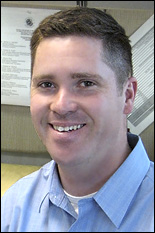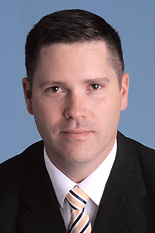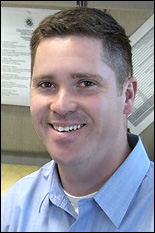News Story
Fisher Speaks at Maryland Stem Cell Symposium

Associate Professor John Fisher.
"The research presented at this event is both impressive and vital to Maryland's long-term future in the life sciences industry. We are blessed to have world-class research institutions and laboratories dedicated to improving the health and quality of life for all people, and we are excited about the possibilities that the Maryland Stem Cell Research Fund offers to discover treatments for life-threatening diseases."
Maryland Governor Martin O'Malley, in a letter featured in the symposium proceedings.
Fisher's presentation, "Human Mesenchymal Stem Cells in Macroporous Cyclic Acetal Hydrogels for Orbital Floor Regeneration," discussed the use of a patient's own autologous mesenchymal stem cells to help him or her heal more effectively from an injury to the bottom, or floor, of the eye socket. Treating these injuries is difficult because the sinuses, which lie below the floors of the eye sockets, are mostly open areas that provide little if any support for the regrowth of bone. Current treatment methods include the use of bone grafts and metal or plastic implants, but the results are often less than ideal, both physically and cosmetically. The development of a tissue engineering strategy for the treatment of facial fractures, Fisher believes, would greatly expand a treating physician's options and improve a patient's quality of life.
Fisher's proposed procedure involves transplanting stem cells from the patient's bone marrow into a synthetic biomaterial that is then transplanted into the damaged area of the face. After implantation, the biomaterial would slowly degrade away while the relocated stem cells would first "reprogram" themselves, becoming bone-forming osteoblasts, and then go on to synthesize new bone tissue at the injury site. In time, fractures and gaps in the skull would be filled in with new, healthy bone.
While this approach has been proposed by many researchers, Fisher's team hypothesizes that the key factor that must be considered for the successful transplantation of cells is the effect of the synthetic biomaterial on the ability of the cells to communicate with each another. Cell-to-cell communication, known as signaling, is a process that has been widely investigated in scientific literature, but little is known about how cells communicate with one another when they exist within a synthetic material, and how it might affect their typical processes, including the production and functioning of signaling molecules they use to pass messages to each other. Part of the group's research will focus on the behavior of the transplanted cells within their biomaterials in order to determine how to create synthetic environments that will best support bone regerneration and cell transplantation in general.
Fisher's colleagues on the project are bioengineering graduate student Martha Betz; John Caccamese, Jr., M.D., D.M.D., F.A.C.S. and Domenick Coletti, M.D., D.D.S. from the Department of Oral & Maxillofacial Surgery at University of Maryland Dental School and the University of Maryland Medical Center's Shock Trauma Center; and John Sauk, D.D.S., Dean of the Dental School at the University of Louisville, Ky.
Related Stories:
"The Face of the Future" »
(From The Diamondback Online.)
"Fisher Receives Stem Cell Funds" »
Published December 5, 2008












